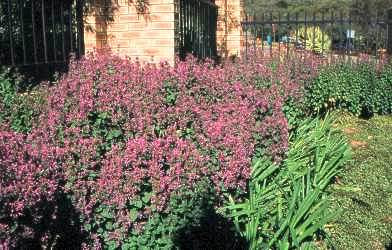While walking through a garden this morning, I stumbled on a very strange plant growing as a 'weed' in a very sad lawn. Its the middle of winter here, so most lawns look like they are just hanging on to life by their bare stolons. The only things that seem to be thriving are the weeds.
I noticed the plant, because of its pretty pink flowers - and although there was something quite familiar about it, I didn't think I had seen it before. That is until I looked closer.
The flowers looked very much like the flowers of a ribbon bush - Hypoestes aristata. For those of you that don't know it, its a great indigenous shrub, that gets covered in pink or purple flowers that look like little bits of ribbon spread all over the place. It normally gets to about 1.5 - 2m in height if its left to its own devices. But here its growing quite contentedly - and its being kept regularly cut at about an inch in height! Given time, it will probably happily replace the lawn.
Hypoestes is a great garden shrub. It likes to be well watered and fed, and if you pay it some nominal attention, it will look good throughout the year. It grows in full sun and shade, but will flower better with more sun.
Its also a favourite snack for most buck along the coastal forest of eastern South Africa - as I found out too late, after planting a garden with it!
Here though, its a great example of the ability of most plants to adapt and thrive in almost any conditions. Without any looking after, its looking green and even flowering. It probably would not have entered my mind, and isn't the ideal, if you're looking for an alternative to lawn. But here it is doing quite well when the grass around it is looking dry and brown.
The search for lawn alternatives hasn't truly begun here in South Africa - the ideal for any SA garden is still a perfect monoculture of grasses that require copious amounts of water and fertiliser, and weekly mowing. But the tide will turn. Eventually. We will begin to realise the real cost of this unsustainable ideal of having most of, and every garden covered in lawn.
The difficulty comes in that, in most peoples minds there is no alternative to a beautiful green lawn - even I sometimes find it hard to imagine anything better. And lets face it very little beats that look of a perfectly mown carpet of grass. But I think its the responsibility of every gardener to help swing the tide by putting alternatives out there. How about a wildflower meadow? Or even planting some indigenous/native grasses to let them grow tall, and cutting pathways through? People want what they see, so we as designers, need to put examples out there to try to coax them out of their comfort zones.
Subscribe to our Growing Gardeners YouTube Channel
Subscribe to:
Post Comments (Atom)
Home Made Pest Control Solution(s)
I'm really not a big fan of pesticides or chemicals. Actually, that's putting it mildly...I hate pesticides. They are almost always ...

-
So...your lawn is looking amazing. The grass has just been manicured...it looks like an immaculate green carpet out there. You couldn't...
-
I read a comment the other day that stated quite matter of factly that using wild grasses in your garden is no longer fashionable...what? Wh...
-
Getting rid of pests in gardens is a tough subject. Its never easy watching bugs or other 'pests' eat their way through your beautif...









4 comments:
I came over here via Alice Joyce and very much enjoy your perspective. Steve Snedeker and Susan Morrison and LostLandscape have interesting ideas about weaning people from lawns: make them small areas that fit into the landscape, and entice your clients with beautiful ideas of lush green moneysaving watersaving worksaving other things.
The U.S. is still mostly addicted to lawns, too, even in areas such as mine where they make no sense whatever.
Thanks P.B., glad you enjoyed it. I think Susan and I have very similar views about sustainable gardening, but I'll check out Steve Snedeker and LostLandscape too.
I think its a movement that will probably take a while to catch on, but it has to start somewhere. If it just makes the average gardener think twice about the impact of huge lawns on their time, pocket and the environment then half the battle is won.
Valid, relevant - but most important: well-written and interestingly illustrated. The way to go, Ross! I will also check out PB's references.
Thanks Jack...by the way, I love your stone cottage - it looks idyllic (apart from the 5 dogs?)
Post a Comment